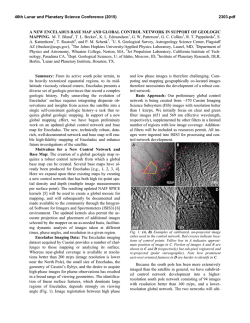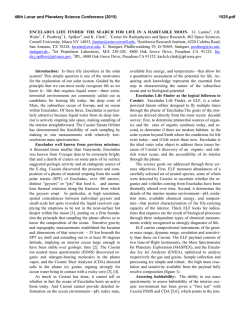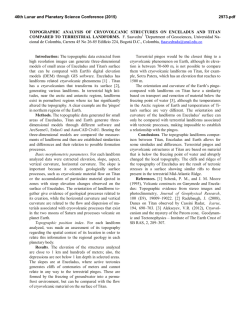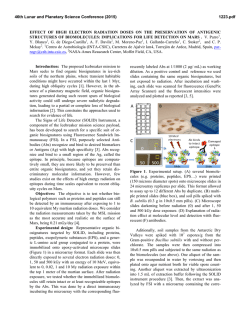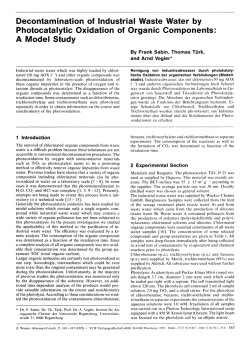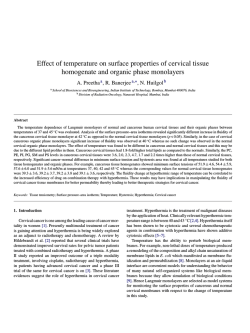
instrumentation and methods for detecting trace organic molecules
46th Lunar and Planetary Science Conference (2015) 2813.pdf LAB-ON-A-CHIP ORGANIC ANALYZER: INSTRUMENTATION AND METHODS FOR DETECTING TRACE ORGANIC MOLECULES AND AMINO ACID CHIRALITY IN PLANETARY SCIENCE. A. L. Butterworth1, A. M. Stockton2, P. Turin1, M. Ludlam1, M. Diaz-Aguado1, J. Kim3, P. Willis4 and R. A. Mathies5 1 Space Sciences Laboratory, University of California, Berkeley, CA. 2Georgia Institute of Technology, Atlanta, GA. 3 Texas Tech University, Lubbock, TX. 4Jet Propulsion Laboratory, California Institute of Technology, Pasadena, CA. 5College of Chemistry, University of California, Berkeley, CA ([email protected]). Introduction: In situ organic analysis has been proven to be a powerful and cost effective approach for detecting molecules of relevance for chemical evolution in our solar system. Biologically important classes of compounds, such as amino acids, show a strong chiral bias on Earth, but racemic amino acids occur in meteorites. Thus far there have been no in situ measurements demonstrating chirality of molecules from extraterrestrial materials. Heritage: A miniature lab-on-a-chip approach for detection and chirality determination of trace organic compounds has been developed extensively over 15 years at UC Berkeley College of Chemistry and Jet Propulsion Laboratory [1-4]. Portable prototypes have been field tested in the Panoche Valley, CA and in the Atacama Desert in Chile, where amino biomarkers of ancient life were detected and dated based on their chiral ratios [1]. The technique employs an integrated microfluidic device (typically 10-cm diameter) to analyze microliter aqueous volume samples for a wide variety of molecular species with part-per-billion sensitivity. The projection of a typical microfluidic chip is shown in Fig. 1. First, organic compounds are automatically labeled according to their chemical functional groups with specific fluorescent reagents in a Programmable Microfluidic Analyzer (PMA). Next, the labeled organic species are separated by high-resolution electrophoretic separation in a microfabricated capillary electrophoresis (µCE) device. Finally, high sensitivity laser-induced fluorescence detection results in molecular identification and chirality (by separation time) and quantitation (by peak intensity). This miniaturized instrument with big science return is ideal for deployment for in situ organic analysis of multiple and varied planetary science targets. We describe below two proposed implementations for planetary exploration - the Mars Organic Analyzer and the Enceladus Organic Analyzer. Mars Organic Analyzer (MOA) Instrumentation: The Mars Organic Analyzer (MOA), developed for NASA Mars 2020 in collaboration with UC Berkeley Space Sciences Laboratory and JPL, was designed to meet the in situ organic analysis needs of that mission by providing the capability to characterize the martian ground-truth organic content of cached samples. Sub-part-per-billion sensitivity is achieved with an integrated instrument that first efficiently extracts organic molecules from soils or drill fines using subcritical aqueous extraction, followed by chemical analysis of the µL-molecular extracts on a multilayer integrated microdevice comprising a PMA-µCE with laser-induced fluorescence detection. The MOA design is a compact 12 kg, 5 watt instrument measuring 22x22x29 cm that analyzes for six different classes of organic molecules [5]. Enceladus Organic Analyzer (EOA) Instrumentation: The icy plumes arising from Enceladus provide an outstanding opportunity to sample organic rich materials from extraterrestrial bodies to characterize possible life or potential for life [6]. This sampling opportunity suggests a novel design concept for a flight- Figure 1: Microdevice at the heart of the Enceladus Organic Analyzer instrument. The processing core is a rectilinear array of valves at the center of the microdevice highlighted green. Reagent storage for multiple samples radiate from the center along spokes towards the top, and sample storage has been highlighted grey. The capillary electrophoresis channel is highlighted red. 46th Lunar and Planetary Science Conference (2015) 2813.pdf Figure 2. Schematic of functional elements and analysis process of Enceladus Organic Analyzer (EOA). The ice plume impacts the capture plate when the lid is open depositing organic molecules. After the lid is closed, the molecules are dissolved and, after passage to the microfluidic processor, the amine-containing molecules in the extract including amino acids are labeled with a fluorescent dye, separated by high resolution capillary electrophoresis, and detected with ppb sensitivity. Biologically significant molecules such as amino acids are identified by their unique mobility and their chirality is determined. ready Lab-on-a-Chip organic analyzer instrument, where we capture elusive volatile samples such as comet comae or Enceladus plumes and analyze them operating an integrated microfluidic device in a low gravity environment. EOA is a simplified version of the MOA instrument concept whose operational schematic is shown in Fig. 2 and its design is shown in Fig. 3. The instrument is flown through the Enceladus plume where a capture plate is used for ice-particle collection; there is no need for solid sample processing and extraction as in MOA; adsorbed organics are merely dissolved and transported to the PMA-µCE microfluidic device for analysis as proposed originally for MOA. EOA is a ~2.5 kg mass instrument, with a 16 cm by 16 cm footprint, and low power operation requirement. It is capable of ppb-organic species detection and chiral measurement of organic molecules such as amines and amino acids. Fluidic management is achieved by using pressured nitrogen. A microfluidic valve array, the Programmable Microfluidic Analyzer, is used to perform labeling of the sample with fluorescent dyes and to process the sample for high resolution electrophoretic analysis and sensitive fluorescence detection. In particular the measurement of amino concentration composition and chirality is especially important for probing for the potential for life or perhaps its actual existence on Enceladus. Many missions, especially to outer Solar System targets like the icy moons of Saturn and Jupiter, or comets, are best approached with in situ instruments because of the formidable risks and costs of sample return. The identity and concentration of a wide range of organic molecules including amines, amino acids, aldehydes, ketones, organic acids, thiols and to polycyclic aromatic hydrocarbons (PAHs) in extraterrestrial samples can be determined with sub-part-per-billion sensitivity using the MOA/EOA concept. The demonstration and deployment of such technology should dramatically advance our knowledge of molecular planetary science. Figure 3: Schematic CAD of the EOA Instrument. The EOA is a 16x16x12 cm instrument with a mass of ~3 kg that can be used for sensitivity partper-billion chemical analysis of organic molecules from plumes or comet tails that impact the capture plate assembly. Acknowledgements: We thank Carolyn Porco for suggesting an Enceladus instrument concept study. References: [1] Skelley A.M. et al. (2005) PNAS USA, 102, 1041‐1046. [2] Beegle L.W. et al. (2011) Aerospace Conference. [3] Kim J. et al. (2013) Anal. Chem., 85, 7682−7688. [4] Mora M.F., Stockton A.M., Willis P.A. (2012) Electrophoresis, 33, 2624-2638. [5] Stockton A.M. et al. (2014) Second International Workshop on Instrumentation for Planetary Missions. [6] Porco C.C. (2006) Science 311, 1393-1401.
© Copyright 2024



